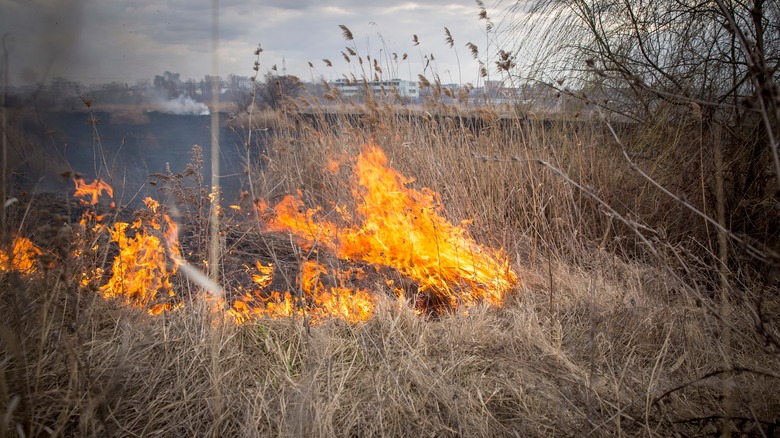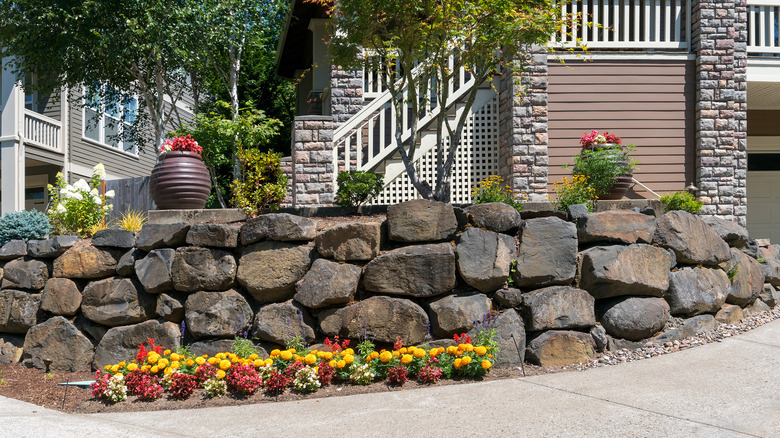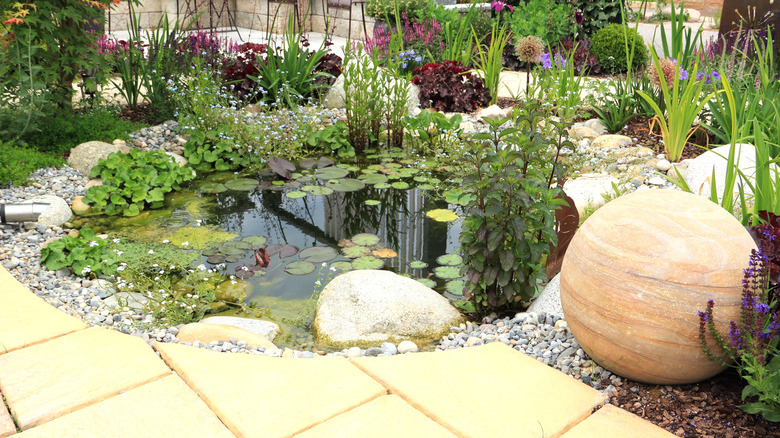What Is A Break Zone And How It May Help Save Your Home
If there's one thing the four corners of the globe have in common, it's natural disasters and specifically destructive wildfires. It's bad enough having to watch as fires rage across the world destroying everything in their wake, but the worst feeling is the terror of helplessness as victims watch their homes and livelihoods burn to ashes. That's why more people, especially those who live in hot, arid climates, are searching for ways to prevent their homes from being susceptible to flames. One of the best ways to make your home more wildfire-resistant is through creating a break zone.
Because our yards are typically covered in flammable grass, trees, and plants, fires can easily start on the lawn and spread to the house and other neighboring properties. By definition, a break zone is made by stripping a portion of land of vegetation and anything that may be combustible in order to stop flames or at least slow them down. Break zones are usually set up in areas with large forestry or agricultural land. Nevertheless, you can still reinvent the concept in your own yard by adjusting your landscape. Taking control of the layout of your house and rearranging flammable vegetation could potentially be your saving grace in the future.
Your yard can contain multiple break zones
YouTube creator Fire Safe Marin shines a more in-depth light on how landscaping and setting up these protective buffers can not only slow down a fire but also allow firefighters more time to reach you and quench the flames. The video shows the first break zone being a stone landscape wall which was erected to slow the fire down. Also, within the lawn is a large concrete patio which protects the house even more by acting as another break zone. On another property, a fire-safe concrete fence is used instead of a wooden one, which helps protect it from flames and embers.
According to the USDA, homes in woodland areas often contain three break zones with the first being at least 5 feet away from the house. If you don't live in the woods, you can set up as many break zones as your land will allow. Basically, you should remove as much flammable material as possible near your home and replace it with items that won't burn as easily, like certain plants and stones. Trees should also be kept as far away from the house as possible. Keep in mind the height of the tree when it's fully mature before planting to make sure it won't be too close to your home. This will protect you from flammable material that could loom over your house and constitute a fire hazard.
Use fire-retardant materials to construct your break zones
There is an art to creating break zones in your yard and it all has to do with knowing where to place fireproof barriers. These fireproof barriers can be any material that would stop or slow down flames, including concrete, gravel, and glass. Your first line of action should be to clear your land of organic material that could encourage the spread of a fire. This means removing dead trees, dried twigs and plants, fallen branches, and crispy leaves. If your grass is dry and unhealthy, cut it down until you get fresh, green grass. Watering your yard is also very important. Set up a regular irrigation schedule and make sure your vegetation receives proper moisture.
Your break zones can also contain structures like ponds, fountains, and fire-retardant plants, which are a huge bonus to your land. Choose plants and trees with a high moisture content. Succulents are a great option, as well as oak and maple trees. It would take them a longer time to catch fire as opposed to plants with thinner stems and leaves. Further, set up your break zones to face the direction that wildfires would most likely follow. A tasteful break zone idea could be a rock garden bordered by a concrete path constructed at least 5 feet away from the house. After the rock garden, your lawn can spread out for another 5 feet and then another break zone can be constructed.


